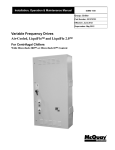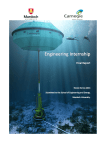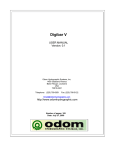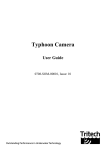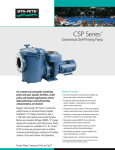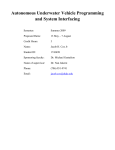Download Meta Media MV-900 Specifications
Transcript
Corrosion testing probes ROV-II™ CP probe Operation manual Twin reference electrodes for online calibration Can be used with ROVs or as a diver-held probe Works as either a contact or proximity probe Use with Polatrak Deep C Meter™ for subsea readout Deepwater Corrosion Services Inc. | 10851 Train Court, Houston, TX 77041 USA +1 (713) 983 7117 | Email: [email protected] | polatrak.com © 2013 Deepwater Corrosion Services Inc. Specifications subject to change without notice Document 354-MN01-ENG Rev. C ROV-II operation manual Table of contents 1. ROV-II components 3 2.1 MSDS sheets 4 4. Installation procedure 4 4.2 ROV installation 5 5. Calibration 6 5.2 Using calibration for troubleshooting 6 5.4 Subsea calibration 7 6. Operation 8 6.2 Recording cathodic protection potentials 8 8. Data interpretation 9 2. Reference documents 4 3. Health and safety 4 4.1 Dive spread 4 4.3 Cautionary notes 5 5.1 General 6 5.3 Topside/bucket calibration 6 5.5 Proximity mode ground check 8 6.1 Wet check 8 7. Taking cathodic protection potential readings 9 9. Maintenance and repair 10 9.2 Reference electrode element replacement 10 9.1 Tip replacement 10 10.Troubleshooting 11 List of figures Figure 1 Soft-splicing the whip onto the comms cable Figure 2 SEA CON® RMG-3FS connector pin diagram Figure 4 Calibration vs. zinc coupon 12 Figure 6 Calibration vs. master Ag/AgCl electrode 14 Figure 8 Wiring schematic for Deep C Meter™ readout 16 4 7 Figure 3 Identifying a failed reference electrode 8 Figure 5 Calibration cell-to-cell 13 Figure 7 Wiring schematic for diver-assisted platform survey 15 List of tables Table 1 Normal cathodic protection ranges for bare carbon steel in seawater 9 Table 2 Troubleshooting quick guide 11 www.polatrak.com | 10851 Train Court, Houston, TX 77041 USA | Telephone: +1 (713) 983 7117 | Email: [email protected] © 2013 Deepwater Corrosion Services Inc. Specifications subject to change without notice 2 Document 354-MN01-ENG Rev. C ROV-II operation manual ROV-II™ Tip Components Nose cone assembly An offshore case is provided with the ROV-II. The case can be filled with seawater so that the probe can be calibrated. Housing Reference electrode element Whip SEA CON® RMG-3FS connector T-handle probe mounts are available for use with ROVs. There’s a stainless steel version (above right) with a shock absorber to protect the probe during stabbing, and another made of Delrin so inspection-class ROVs can handle their weight. Both are available with fish-tail handles. Serial number Reference electrode element Tail assembly Hex screws The Deep C Meter™ LED readout can be used with the ROV-II to record readings without utilizing the ROV’s umbilical. www.polatrak.com | 10851 Train Court, Houston, TX 77041 USA | Telephone: +1 (713) 983 7117 | Email: [email protected] © 2013 Deepwater Corrosion Services Inc. Specifications subject to change without notice 3 Document 354-MN01-ENG Rev. C ROV-II operation manual 2. Reference documents 2.1MSDS sheets 2.1.1 Dow Corning – 4 Electrical Insulating Compound MSDS – connector sealant http://www.dowcorning.com/applications/search/products/details.aspx?prod=01903128&type=prod PLEASE CONTACT YOUR POLATRAK REPRESENTATIVE FOR ANY QUESTIONS AND/OR ISSUES REGARDING THIS MANUAL. 3. Health and safety It is the intention of Deepwater Corrosion that all test and inspection procedures are carried out in a safe manner in accordance with the Health and Safety At Work Act and any other relevant legislation. If required by the client, Deepwater personnel will attend any site safety induction courses before carrying out work on-site. 4. Installation procedure 4.1 Dive spread 4.1.1 When used with diving operations, assemble a cable with a SEA CON® RMG-3FS connector at the subsea end. In our experience, the most suitable cable is the four (4) conductor armored spiral comms cable used by most divers for diver communications; it has two twisted pairs and is very rugged. A whip with this connector is provided with the probe and should be soft-spliced onto the end of the comms cable (see Fig. 1). Ensure that the connection is taped back to the armored wire to provide strain relief to the subsea connector. Figure 1 - Soft-splicing the whip onto the comms cable Comms cable To topside digital voltmeters or LED readout SEA CON® RMG-3FS connector Soft splice Tail assembly 6’ Whip ROV-II 4.1.2 If required, Deepwater Corrosion can provide a complete assembly on a 500-foot-long umbilical cable. 4.1.3 The appropriate length of cable should be married into the dive hose, leaving 4-6 feet (1.2m – 2m) of slack at the subsea end and at least 50 feet (15m) at the topside end. Always install the dummy plug on the connector when the probe is not attached. 4.1.4 The topside end of the cable will be run to the dive control area along with the platform ground cable and any ground from pipeline risers. The connections can be made to a pair of digital multimeters (refer to fig. 6, wiring schematic for diver-assisted platform survey.) www.polatrak.com | 10851 Train Court, Houston, TX 77041 USA | Telephone: +1 (713) 983 7117 | Email: [email protected] © 2013 Deepwater Corrosion Services Inc. Specifications subject to change without notice 4 Document 354-MN01-ENG Rev. C ROV-II operation manual 4.2 ROV installation 4.2.1 The probe is best installed in or on a manipulator but may be attached directly to the ROV frame if there is no manipulator available. (This should be done when only proximity readings are required). 4.2.2 The recessed grooves in the probe body may be used to accommodate stainless steel hose clamps for attachment. We recommend installing neoprene rubber pads between the probe and the mounting surfaces and attaching a safety line to the probe. This will provide a better attachment and some degree of compliance. 4.2.3 A male SEA CON® RMG-3FS connector on a 6’ (2m) whip is provided to facilitate splicing into the ROV junction box. 4.2.4 Routing the two reference electrode wires in a shielded twisted pair in the ROV umbilical is recommended. The tip wire can be connected to a coaxial cable or any other cable that is straight-through to the control van with no breaks. 4.2.5 Topside, the system can be wired directly to a pair of digital multimeters (Fig. 7) or a Polatrak Deep C Meter (Fig. 8). It can also be wired directly into a video annotator with an input impedance of at least 1 MΩ 4.3 Cautionary notes Polatrak sintered silver / silver chloride reference electrode elements are designed to be rugged, but they are consumables that have a given operational life. The life of these electrodes can be extended to several seasons if the following care is taken: 4.3.1 Never allow the electrode elements to be directly shorted to ground or any other metallic object when immersed in seawater. 4.3.2 Never use the electrode subsea with the underwater connector un-mated. 4.3.3 Never read the ROV-II probe with an analog voltmeter. Ensure that high-input impedance digital equipment is used. 4.3.4 Never handle the bare reference electrode element (small gray pellet) with bare hands. 4.3.5 Do not use any type of solvent or detergent on the probe. Rinse only in fresh water after every operation. 4.3.6 Never immerse the electrode in anything but fresh water or seawater. 4.3.7 Never allow a connector or bulkhead to be immersed unless it is mated or has a sealing dummy plug inserted. 4.3.8 Never read the electrode on a multimeter scale other than DC Volts. 4.3.9 When not in use, store the probe in the provided container filled with seawater or tap water. Probe can be stored dry between jobs but should be soaked in fresh water for at least one hour before storage. 4.3.10 Do not attempt to field-repair any wires on the probe or inside the probe and never attempt to modify the probe tip in any way. www.polatrak.com | 10851 Train Court, Houston, TX 77041 USA | Telephone: +1 (713) 983 7117 | Email: [email protected] © 2013 Deepwater Corrosion Services Inc. Specifications subject to change without notice 5 Document 354-MN01-ENG Rev. C ROV-II operation manual 5. Calibration 5.1 General As with any subsea measurement device, it is important to calibrate the ROV-II probe to ensure that the reference electrodes are working properly and that there is no damage to the probe. If the probe is not calibrated, readings may be incorrect and the dive may have to be repeated. Since the ROV-II probe uses two reference electrodes, the user always has two independent voltage readings of the tip contact. This provides an advantage over probes that use a single reference electrode because the cell-to-cell value can be checked at any time during operation to verify the probe is calibrated and working properly. The cell-to-cell value is simply the difference in voltage between the two readings; this value should never exceed 5 mV topside and 10mV subsea. For example, if both voltage readings are the same, the cell-to-cell value is 0 (zero) mV. 5.2 Using calibration for troubleshooting Certain problems could cause the probe to be out of calibration. A common cause, particularly on diver surveys, is damage to the cable insulation. This causes an offset in the voltage readings, which would usually be interpreted as inadequate protection levels. Other causes include one or more defective reference cell electrodes, wire damage within the probe or mud that has gotten inside the probe. Calibration can be used to quickly diagnose a defective reference electrode or cable damage and should be performed before, during, and after every use. NOTE: Company calibration specifications must be met, but we strongly advise also using the attached procedures. 5.3 Topside/bucket calibration There are two types of bucket calibrations that can be performed: • Zinc coupon calibration • Cell-to-cell calibration Wiring schematics for these two bucket calibrations are shown in Figures 4-5. CAUTION: Never use a metallic container for storage or for performing calibrations. 5.3.1 Fill a non-metallic bucket or container approximately 18 in. (45 cm) deep with seawater or simulated solution with a specific gravity between 1.021 and 1.028. 5.3.2 Place the probe in the bucket, allowing the body to fill with seawater. The entire probe, including the tip, must be immersed. CAUTION: DO NOT immerse the Seacon RMG-3FS connector in water unless it is mated with the dummy plug. 5.3.3 Wait 30 minutes for the electrode elements to reach equilibrium (first time use only). 5.3.4 To perform a zinc coupon calibration: • Immerse the zinc calibration coupon. Stab the probe tip firmly onto the zinc coupon. • Using a digital voltmeter set on 2.00 V DC scale, contact pin socket #1 (the large socket; refer to Figure 2) with the positive voltmeter lead. This pin socket measures the probe tip. • At the same time, contact pin socket #2 (first clockwise of the large pin socket) with the nega- www.polatrak.com | 10851 Train Court, Houston, TX 77041 USA | Telephone: +1 (713) 983 7117 | Email: [email protected] © 2013 Deepwater Corrosion Services Inc. Specifications subject to change without notice 6 Document 354-MN01-ENG Rev. C ROV-II operation manual tive lead and note the reading. Then take the negative lead and contact pin socket #3; note the reading. • Figure 4 shows the correct wiring schematic and the expected results. The two readings should not be more than 5 mV apart. • Remove the probe tip from the zinc coupon. The reading should revert to a voltage within the range of (-) 0.200 to (-) 0.400 V DC. 5.3.5 To perform a cell-to-cell calibration: • Using a digital voltmeter set on 200 mV DC scale, contact pin socket #2 with the positive voltmeter lead and pin socket #3 with the negative voltmeter lead. Note the reading. • Figure 5 shows the correct wiring schematic and the expected results. The reading should be between ±5 mV. Figure 2 - SEA CON® RMG-3FS connector pin diagram Pin socket 1: Contact tip Pin socket 2: Reference electrode #1 (R1) Pin socket 3: Reference electrode #2 (R2) 5.4 Subsea calibration The cell-to-cell value can be checked at any time while the ROV-II probe is deployed subsea. Subsea calibration should be performed with the entire cable immersed, as it will quickly detect any cable damage. Diver surveys using the ROV-II probe should have two topside multimeters connected to the dive cable. ROV-assisted surveys should have the Polatrak Deep C Meter alongside the probe to provide a subsea LED readout of the voltages. Wiring schematics for these two options can be seen in Figures 7-8. CAUTION NEVER submerge any unmated Seacon connectors. 5.4.1 While the probe is free-flying subsea without contacting any metal, the voltage readings will vary depending on ROV/diver speed, time of immersion and whether the tip contact has recently stabbed a structure or pipe. Normally, the voltage readings will be in the range of (-) 200 to (-) 400 mV. 5.4.2 Both voltage readings should never be more than 10 mV apart while the probe is subsea. Remember, this difference between voltage readings is the cell-to-cell value. If the cell-to-cell value is greater than 10 mV, the cause may be: • Lead wire is damaged, exposing copper to seawater. • A connection is not properly mated or is leaking. • One or more reference electrode elements has failed. 5.4.3 If it becomes apparent in the middle of an operation that one reference electrode element has failed, it is possible to complete the dive. Follow these steps to isolate the bad reference electrode: www.polatrak.com | 10851 Train Court, Houston, TX 77041 USA | Telephone: +1 (713) 983 7117 | Email: [email protected] © 2013 Deepwater Corrosion Services Inc. Specifications subject to change without notice 7 Document 354-MN01-ENG Rev. C ROV-II operation manual • Stab the probe onto the structure and determine which reading displays the most positive voltage; this is normally the failed reference electrode. The good reference electrode will have the most negative reading. For example, (-) 900 mV is more negative than (-) 800 mV. (-) 900 mV would indicate the good reference electrode; (-) 800 mV would indicate the failed reference electrode. • Record the cell-to-cell value. • Only use the voltage readings from the good reference cell for the rest of that dive. Figure 3 - Identifying a failed reference electrode Most negative reading: Indicates good electrode Most positive reading: Indicates failed electrode 5.5 Proximity mode ground check When the probe is being used in proximity mode, the user needs to verify that the platform ground wire and probe tip will yield the same reading at any point on the main structure. • Stab the steel structure with the probe and record the voltage reading. • Take the reading again using the platform reference ground wire instead of the probe tip. The readings should be identical. If the readings vary by more than 3 mV, check the platform ground wire connection. 6. Operation Most companies have their own survey procedures to follow. The following guidelines are given as guidance only. 6.1 Wet check 6.1.1 When interfaced to an ROV, it’s important to perform a wet check before every dive. Signal errors caused by umbilical power cable interference could introduce reading errors. 6.1.2 With the probe wired to the ROV, immerse the system to a depth of at least –30 feet (–10 m), and with the vehicle still in its Tether Management System (TMS), bring up one electrical system at a time and note the potential of the tip. (It will vary some depending on immersion time). If there is a problem, the potential will change rapidly or will spike when the circuit is powered. Repeat for all electrical and hydraulic systems. If a problem is detected, it should be fixed. Usually, the cause is a poor ground connection or a faulty leaking underwater connector. The system at fault can be switched off if it will not hinder operation. 6.2 Recording cathodic protection potentials If wired correctly, the cathodic protection potentials should have a negative polarity. Accurate readings will be steady as long as the probe is not moving. If readings are erratic, this is a sign of a connection problem and the cause should be isolated and fixed. www.polatrak.com | 10851 Train Court, Houston, TX 77041 USA | Telephone: +1 (713) 983 7117 | Email: [email protected] © 2013 Deepwater Corrosion Services Inc. Specifications subject to change without notice 8 Document 354-MN01-ENG Rev. C ROV-II operation manual 7. Taking cathodic protection potential readings Stab the tip-contact probe onto the point on the structure where the reading is required. When a good contact is made, the displays will show a steady reading. CAUTIONS • Avoid stabbing painted or coated surfaces whenever possible. Try to take readings on bare steel or on spots specially designated for cathodic protection measurement. • If necessary, anodes can be stabbed. However, it is best to stab the anode band if possible. • Avoid trying to stab through heavy, hard marine growth. • The probe unit should be kept out of the mud, which will contaminate the electrodes. • If the readings are not steady or do not match the criteria in Table 1, the cause is probably due to a high-resistance contact. DO NOT RECORD THESE NUMBERS. Continue to stab until readings are within the range specified in Table 1. See troubleshooting section if problems persist. • NEVER operate the system with any of the connectors un-mated unless the dummy plugs are installed. 8. Data interpretation For carbon steel structures in seawater, the readings obtained should be within the ranges in Table 1. Exceptions may occur if the probe is stabbed onto an isolated section of a corrosion-resistant alloy such as stainless steel, copper or nickel. In these cases, readings less negative than the indicated range may be noted. If so, ensure that the readings are steady and within the ±5 mV allowable tolerance. Table 1 - Normal cathodic protection ranges for bare carbon steel in seawater Range (mV) Interpretation Action -500 or more positive Error Remake contact & verify Measure two other points around the component Abort & refer to troubleshooting section -501 to -649 Isolated from cathodic protection -650 to -799 Not cathodically protected -800 to -849 Marginal cathodic protection -850 to -1049 Cathodically protected -1050 to -1149 Anode potential -1150 or more negative Remake contact & verify Record data Record data Remake contact & verify. Measure two other points around the component Abort & refer to troubleshooting section Error www.polatrak.com | 10851 Train Court, Houston, TX 77041 USA | Telephone: +1 (713) 983 7117 | Email: [email protected] © 2013 Deepwater Corrosion Services Inc. Specifications subject to change without notice 9 Document 354-MN01-ENG Rev. C ROV-II operation manual 9. Maintenance and repair This section covers general operational maintenance. Do not attempt any task not described in this section, as it may damage the system. 9.1 Tip replacement From time to time it will be necessary to replace tips. Remove the old tip with a 7/16 in. wrench (flats are best). Avoid using an adjustable wrench if possible. Ensure that the new tip is tight. CAUTION: The contact tip has been machined to a very sharp point to enable easier readings through coatings. This point can also easily cut or poke through human skin. Please handle with care. 9.2 Reference electrode element replacement Spare plug-in electrode elements are available for the ROV-II probe. These elements will also work in the Polatrak CP Gun. If one element or more needs to be changed, follow this procedure: 9.2.1 Remove the probe from the ROV and un-mate the connector. Install the provided dummy plug onto the exposed flying lead connector. 9.2.2 Perform a zinc coupon bucket calibration as described in section 5.3.4. The faulty electrode will be the one that gives the more positive reading. 9.2.3 Ensure that the probe is drained of seawater. 9.2.4 Take the probe unit to a clean area. 9.2.5 DO NOT handle the small electrode pellet with bare hands. 9.2.6 Remove the two screws securing the tail unit and gently pull out the tail unit to expose the electrode elements. Try to avoid un-mating the tip connector. 9.2.7 Visually inspect to ensure that the wire is not damaged and the connector is properly mated. 9.2.8 Remove the bad electrode and discard according to appropriate local environmental procedures. 9.2.9 Take the new electrode and carefully place a small amount of insulating compound on the sealing section of the electrode connector. Please refer to the MSDS in appendix before handling sealant. All appropriate Personal Protective Equipment (PPE) shall be worn, including safety glasses, as a minimum. 9.2.10 Plug in the new electrode. 9.2.11 Check that all connectors are fully mated, then carefully put the electrodes back into the housing and re-attach the tail unit and nose cone. 9.2.12 Repeat calibration as described above. (Note that a new dry element may take up to 30 minutes to reach equilibrium) Caution: NEVER immerse an electrode element in water with the connector pin exposed. www.polatrak.com | 10851 Train Court, Houston, TX 77041 USA | Telephone: +1 (713) 983 7117 | Email: [email protected] © 2013 Deepwater Corrosion Services Inc. Specifications subject to change without notice 10 Document 354-MN01-ENG Rev. C ROV-II operation manual 10. Troubleshooting 10.1 The cell-to-cell value is greater than 5 mV topside or 10 mV subsea The problem could be one of the following: • One reference electrode has failed. Repeat the bucket calibration (section 5.3). The electrode with the more positive reading is probably in error. Replace the reference electrode element (section 9.2). • There is damage to the tail assembly cable or umbilical cable. When recovering the ROV-II Probe from the dive, any cable damage can be quickly located and repaired. Monitor the cell-to-cell value as the cable comes out of the water. If the problem is cable damage, the cell-to-cell value will revert to the acceptable range (10 mV or less) as soon as the damaged area of cable clears the water. 10.2 Both displays reading low (more positive) voltages If both electrodes read low during a stab (more positive than (–)500 mV), the problem is probably with the contact tip wire attached to the nose cone assembly. If the tip wire is damaged, a temporary soft-splice repair can be made using ScotchKote® sealant (not included) and splicing tape. However, prolonged operation in this manner is not recommended. Order a new nose cone assembly as soon as possible. 10.3 Recalibration After any replacement or repair, recalibrate the instrument by performing a bucket calibration as described in section 5.3. Table 2 - Troubleshooting quick guide Symptom Instrument will not calibrate Both electrodes reading low Possible problem Action One electrode is bad See section 9.2 Zinc coupon is passivated Remove zinc and clean with rasp Electrodes are dry Soak in seawater for 30 minutes and retry Tip wire damaged Remove probe tail unit, unplug tip wire, remove nose cone, inspect tip wire and repair with ScotchKote as temporary measure. Order replacement nose cone. Readings are not steady and Voltmeter batteries are low continue to change. Poor structure contact One reading suddenly goes less negative Deep C Meter LED readouts are blank Replace voltmeter batteries Re-stab to ensure contact. Connector is flooded Check connectors Lead wire (flying lead) is nicked. Inspect and repair / replace as necessary Not enough light to photo-cell Increase light intensity and re-direct to center of lens. Batteries are dead Replace batteries Pressure housing is flooded Go to backup; return unit to Polatrak. 10.5 If a problem persists or is not listed, please call our hotline at (713) 983-7117 and ask for PolaTrak technical support. www.polatrak.com | 10851 Train Court, Houston, TX 77041 USA | Telephone: +1 (713) 983 7117 | Email: [email protected] © 2013 Deepwater Corrosion Services Inc. Specifications subject to change without notice 11 Document 354-MN01-ENG Rev. C ROV-II operation manual Figure 4 Cell to Zn coupon ROV-II calibration wiring schematic Calibration voltmeter display at 2 Volts DC setting Seawater solution Non-metallic bucket Zn calibration coupon Step +VE —VE DC scale Expected result 01 Tip / Pin 1 Reference electrode 2 / Pin 3 2V –1.030 to –1.070 02 Tip / Pin 1 Reference electrode 1 / Pin 2 2V –1.030 to –1.070 (Readings should be within ±0.005V of each other) www.polatrak.com | 10851 Train Court, Houston, TX 77041 USA | Telephone: +1 (713) 983 7117 | Email: [email protected] © 2013 Deepwater Corrosion Services Inc. Specifications subject to change without notice 12 Document 354-MN01-ENG Rev. C ROV-II operation manual Figure 5 Cell to cell ROV-II calibration wiring schematic Calibration voltmeter display at 200 mV DC setting Seawater solution Non-metallic bucket Step +VE —VE DC scale Expected result 01 Pin 3 Reference electrode 1 / Pin 2 200 mV ±5.0 mV 02 Pin 2 Reference electrode 2 / Pin 3 200 mV ±5.0 mV www.polatrak.com | 10851 Train Court, Houston, TX 77041 USA | Telephone: +1 (713) 983 7117 | Email: [email protected] © 2013 Deepwater Corrosion Services Inc. Specifications subject to change without notice 13 Document 354-MN01-ENG Rev. C ROV-II operation manual Figure 6 Cell to Ag/AgCI master ROV-II calibration wiring schematic Note: This calibration procedure is only performed by qualified Polatrak technicians before shipment or during repair. Calibration voltmeter display at 200 mV DC setting Seawater solution Non-metallic bucket Ag/AgCI master electrode Step +VE —VE DC scale Expected result 01 Master Reference electrode 1 / Pin 2 200 mV 0 mV ± 5.0 mV 02 Master Reference electrode 2 / Pin 3 200 mV ±5.0 mV 03 Master Tip / Pin 1 2V -3 V ± 0.1 V www.polatrak.com | 10851 Train Court, Houston, TX 77041 USA | Telephone: +1 (713) 983 7117 | Email: [email protected] © 2013 Deepwater Corrosion Services Inc. Specifications subject to change without notice 14 Document 354-MN01-ENG Rev. C ROV-II operation manual Figure 7 Wiring for diver-assisted platform survey ROV-II wiring schematic Survey voltmeter display at 2 Volts DC setting www.polatrak.com | 10851 Train Court, Houston, TX 77041 USA | Telephone: +1 (713) 983 7117 | Email: [email protected] © 2013 Deepwater Corrosion Services Inc. Specifications subject to change without notice 15 Document 354-MN01-ENG Rev. C ROV-II operation manual Figure 8 Wiring for Deep C Meter™ readout ROV-II wiring schematic SEA CON® connector Pin 1: Contact tip Pin 2: Reference electrode #1 (R1) Pin 3: Reference electrode #2 (R2) www.polatrak.com | 10851 Train Court, Houston, TX 77041 USA | Telephone: +1 (713) 983 7117 | Email: [email protected] © 2013 Deepwater Corrosion Services Inc. Specifications subject to change without notice 16 Document 354-MN01-ENG Rev. C
















